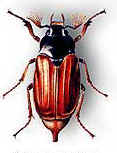
COCK CHAFER |

After the mass outbreaks of 1944-1958 the population declined strongly in NW and
central Europe. Erroneously this decline was claimed to have been caused by the use of
agrochemicals. At the turn of the 19th to 20th century the Swiss naturalist Decoppet
discovered a 30-40 years' cycle in Cock chafer populations. He described the control of
chafers by means of mass collecting of adults by schoolchildren during the past centuries.
The churches payed by the basket and this was noted carefully by the church clercks.
Decoppet made an inventarization of the church registers and came to the above mentioned
conclusion. The last known mass flight of Cock chafers in the Netherlands occurred from
the mid-forties until the late fifties. In the nineties a new Cock chafer period was to be
expected. According to investigations during the flight period around 1950 it is likely to
expect a ca. ten-year flight period. Predictions about the duration of the present
problems and the seriousness of expected damage are difficult. Like in the Netherlands
reports of Cock chafer damage has been recorded in Germany, Switzerland and Northern
Italy. The cause of this cyclicity is still unknown.
A generation of Cock chafers in middle Europe lasts for three or four years whereas in
Southern Scandinavia one generation occurs every five years. Presumably the second and
third instar moves to deeper layers of the soil during unfavourable conditions (lack of
food, low temperatures, high moisture conditions). Under these conditions the grubs stay
longer in the second or third instar whereas populations developing under more favourable
conditions complete a generation in three years.
Copyright © Insect Consultancy 2002